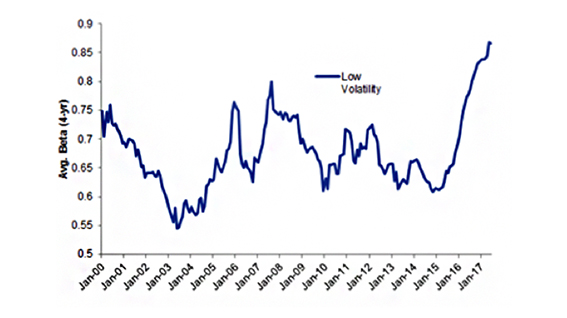Invest
How much risk are you taking?
Every year in Australia as we approach the summer months, the Rural Fire Service undertakes a scheduled hazard reduction process known as back-burning.
How much risk are you taking?
Every year in Australia as we approach the summer months, the Rural Fire Service undertakes a scheduled hazard reduction process known as back-burning.

The principle is straightforward: by clearing bushland of accumulated fuel (kindling) through controlled burning, the Rural Fire Service can help prevent larger, uncontrollable infernos.
Hazard reduction is an important and often overlooked part of investing. Markets have a tendency to move between states of fearing the future where people believe there is no justification for being in markets (usually coincides with market bottoms), to believing that risk is easily measured and controlled. At that point, the fear of missing out is all encompassing (and correlations with a market top are typically quite high).
There are several measures that we look at to give an indication of attitudes towards risk. One example is the Chicago Board Options Exchange volatility or VIX index, which is a measure of implied volatilities based on a number of S&P 500 index options.
Some market participants believe the VIX index reflects the risk in the market at a point in time. Our view, however, is that it reflects what people believe is the current risk in the market and it becomes self-fulfilling. As markets climb, the VIX index usually falls, as investors believe that risk is falling.

In our opinion, investors should be thinking quite the opposite.
Risk in low volatility stocks are at 20-year highs
We can observe the behaviour of investors by looking at the current valuations that the market is willing to pay to gain access to a company’s future dividends and cash flows. Below is a chart supplied by Goldman Sachs, which shows the beta (a measure of volatility or systemic risk of a company) for ‘low volatility’ companies.
The systematic risk of 'Low Vol' stocks sits at a 20-year high
Average beta (4-yr vs ASX 200) of 'low volatility' stocks.

Source: Goldman Sachs Global Investment Research, FactSet, IRESS, I/B/E/S
Historically, 'low volatility' stocks have had lower levels of market risk. The chart indicates that the market has pushed up the prices of what are considered ‘low volatility’ stocks. If you purchase these companies today, you are taking on close to market risk or materially higher risk than has historically been the case. A sample of the stocks included in this ‘low volatility’ basket are listed below:
- Telstra
- Transurban
- Scentre Group
- Commonwealth Bank of Australia (CBA)
- Stockland
- GPT Group
- National Australia Bank (NAB)
- Australia and New Zealand Banking Group (ANZ)
- Westpac Banking Corporation
- APA Group
- Mirvac
- Spark Infrastructure
- Suncorp Group
- Investa Office Fund
- CSL Limited
These companies tend to have low volatility in earnings and cashflow. Due to low interest rates the market has pushed the valuations of these companies up to a point whereby any change to expectations of interest rate changes may lead to a material change in the value of these companies.
Change is in the air
Analysis of the balance sheets of these companies shows that quite a few of them have significant levels of financial leverage. This is in part due to a market environment over the past 10 years where interest rates have been extremely low and real rates have been negative.
As long as interest rates do not rise, these valuations may be justifiable.
However, many central bankers, from the Federal Reserve to the European Central Bank to the Bank of England, have been jawboning about unwinding the asset purchases that have occurred over the last ten years, which will place upward pressure on the long end of the interest rate yield curve.
Even the Reserve Bank of Australia has been talking about a neutral interest rate setting for Australia. That's likely to be around 3.5 per cent – which is materially above current levels.
Two key takeaways
The adage goes that where there’s smoke there’s usually a fire, and Perpetual’s conservative approach to investing has a proven record of acting as an early warning system for investors.
Firstly, and most importantly, be aware of what price/valuation you are paying to get access to a company’s future cash flows/dividend stream.
Secondly, the valuation that other investors are willing to pay can tell you critical information about the risk appetite of the market. The above example shows that the valuations of ‘low risk/low volatility’ companies have been pushed up to levels whereby investors may be taking on a lot more risk than they think.
Vince Pezzullo is deputy head of equities, portfolio manager at Perpetual.

Investment insights
Centuria announces senior internal promotions, strengthening leadership team for new property growth cycle
Centuria Capital Group (ASX: CNI or "Centuria") has strengthened its senior management structure with several internal promotions, effective from Monday, 15 April 2024. The new senior roles are part ...Read more

Investment insights
Institutions and wealth managers favour fixed income over equities, research shows
New research from Managing Partners Group (MPG), the international fund management group, shows professional investors believe fixed income is becoming more attractive than equities over the next 12 ...Read more

Investment insights
Gold prices soar to record high: Two surprising factors fueling the surge
Gold prices have hit a fresh record high, nearing $2,300 an ounce in Thursday trading, and while geopolitical tensions and expectations of interest rate cuts by the US Federal Reserve are commonly ...Read more

Investment insights
Alternative fund managers expect increased fines for regulatory breaches, survey reveals
A new study by Ocorian, a market leader in regulation and compliance services, has revealed that alternative fund managers anticipate a rise in fines for breaking regulations in their sectorsRead more

Investment insights
Institutional investors set to increase allocations to illiquid assets, MPG research reveals
A new study by international asset management company Managing Partners Group (MPG) has found that more than three-quarters (78%) of institutional investors and wealth managers plan to increase their ...Read more

Investment insights
Vanguard reduces management fee for its Australian Government Bond Index ETF
Vanguard Australia has announced a reduction in the management fee for its Vanguard Australian Government Bond Index ETF (ASX:VGB) by four basis points to 0.16% per annum, effective from Monday. Read more

Investment insights
Institutional investors and wealth managers recognise digital assets' role in diversification
A new global research study by London-based Nickel Digital Asset Management (Nickel), a regulated and award-winning digital assets hedge fund manager, reveals growing mainstream acceptance of digital ...Read more

Investment insights
Chinese and European brands dominate top 5 most valuable insurance brands: Brand Finance report
The latest Brand Finance Insurance 100 2024 report reveals that Chinese and European brands continue to dominate the ranking of the world's most valuable insurance brands. Read more

Investment insights
Centuria announces senior internal promotions, strengthening leadership team for new property growth cycle
Centuria Capital Group (ASX: CNI or "Centuria") has strengthened its senior management structure with several internal promotions, effective from Monday, 15 April 2024. The new senior roles are part ...Read more

Investment insights
Institutions and wealth managers favour fixed income over equities, research shows
New research from Managing Partners Group (MPG), the international fund management group, shows professional investors believe fixed income is becoming more attractive than equities over the next 12 ...Read more

Investment insights
Gold prices soar to record high: Two surprising factors fueling the surge
Gold prices have hit a fresh record high, nearing $2,300 an ounce in Thursday trading, and while geopolitical tensions and expectations of interest rate cuts by the US Federal Reserve are commonly ...Read more

Investment insights
Alternative fund managers expect increased fines for regulatory breaches, survey reveals
A new study by Ocorian, a market leader in regulation and compliance services, has revealed that alternative fund managers anticipate a rise in fines for breaking regulations in their sectorsRead more

Investment insights
Institutional investors set to increase allocations to illiquid assets, MPG research reveals
A new study by international asset management company Managing Partners Group (MPG) has found that more than three-quarters (78%) of institutional investors and wealth managers plan to increase their ...Read more

Investment insights
Vanguard reduces management fee for its Australian Government Bond Index ETF
Vanguard Australia has announced a reduction in the management fee for its Vanguard Australian Government Bond Index ETF (ASX:VGB) by four basis points to 0.16% per annum, effective from Monday. Read more

Investment insights
Institutional investors and wealth managers recognise digital assets' role in diversification
A new global research study by London-based Nickel Digital Asset Management (Nickel), a regulated and award-winning digital assets hedge fund manager, reveals growing mainstream acceptance of digital ...Read more

Investment insights
Chinese and European brands dominate top 5 most valuable insurance brands: Brand Finance report
The latest Brand Finance Insurance 100 2024 report reveals that Chinese and European brands continue to dominate the ranking of the world's most valuable insurance brands. Read more






